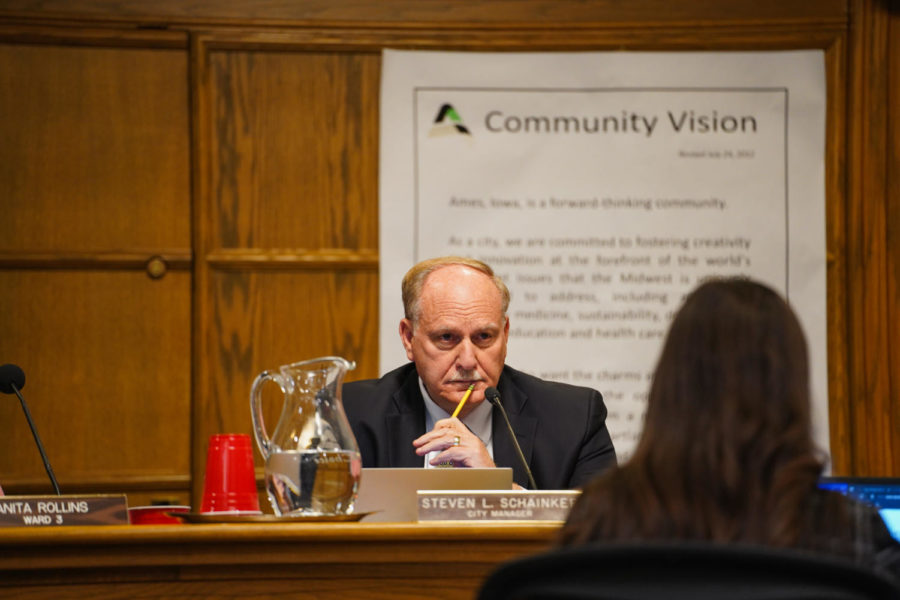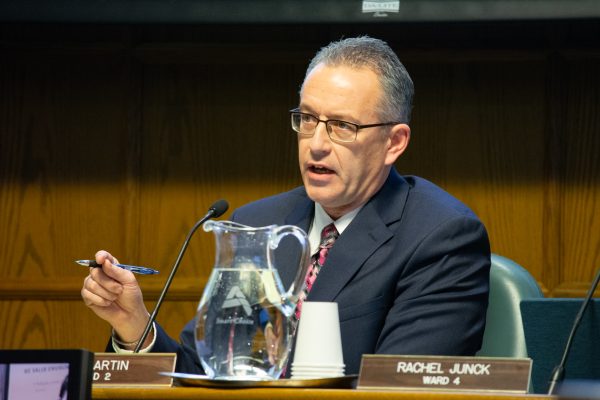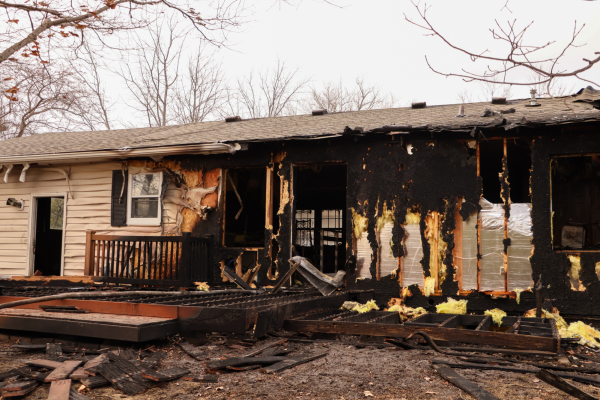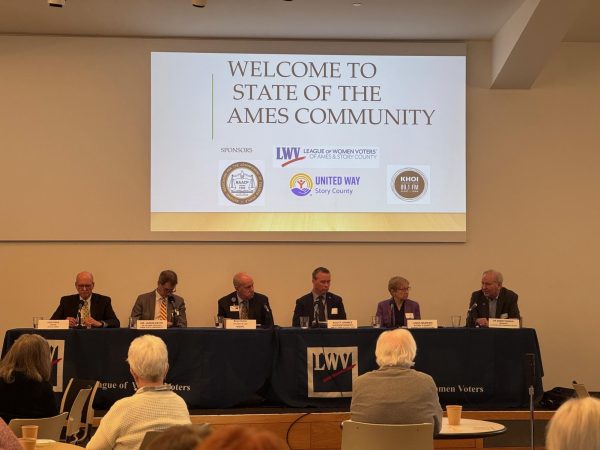Indoor aquatic center estimate $3.1 million over budget
Ames City Manager Steven Schainker listens to a concerned citizen on Jan. 24.
City staff presented the initial Fitch Family Aquatic Center schematic design on Tuesday that estimated the construction cost is $3.1 million more than the budgeted $20.5 million, excluding the alternate bid that adds a $2.9 million walking track.
According to Ames Director of Parks and Recreation Keith Abraham, the schematic design is a conservative estimate, and the council should allow the process to continue as planned.
Abraham said the developers of the project have indicated that the overall price will be lower once they have more accurate construction estimates.
“We think what we need to do is continue to work with the consultants [to] look at the design [and see] what can we do to get that number back down to $20.5 million,” Abraham said.
City Manager Steve Schainker said the council has a tough task ahead of them.
“Either way, it’s going to be challenging,” Schainker said. “We’re looking at $5.5 million we’re going to have to cut costs or identify additional revenue to accomplish the base bid and the alternate bid.”
Mayor John Haila said the council needs to accept that they are in a volatile construction market.
“It just seems pretty early in the process to all of the sudden start raising and saying we’re going to pay more money and all of the sudden then when you find out ‘oh it’s even more money,’ then you’ve basically exhausted your options,” Haila said.
Ward 2 Rep. Tim Gartin said it is hard for him to be optimistic about the lower estimate.
“The last year has been so hard for [the] council to watch so many bids come in well above the engineering estimate; it’s hard for me to be optimistic about that,” Gartin said. “The council itself has added $3-4 million to this project by the decision to locate it on a contaminated soil site.”
The city is in the process of establishing a contract with Impact 7G to provide feedback and recommendations to the council on environmental issues like the previously reported contaminated soil.
Gartin, who also donated to the aquatic center project, was the sole vote against the purchase of the former Iowa Department of Transportation site because of the soil contamination.
Abraham also said the Iowa Department of Natural Resources will not allow vertical geothermal wells due to aquifers.
“I didn’t know until this meeting that we run the risk of endangering our aquifers. The risk to our children was not enough,” Gartin said. “Why in the world would anyone build a pool for children and our residents on a contaminated soil site?”
Haila said if the council decides to stay at $20.5 million for construction costs, then the burden is on the designers to reduce the costs rather than the burden being on the city to pay more.
“If you raise the budget, they’re going to expect we’re going to pay for that, not go back later on and say, ‘Oh no, we don’t want to pay that much money,’ you gotta set that standard at this point,” Haila said.
Ward 1 Rep. Gloria Betcher said the council could consider cost savings with the design of the building.
“It’s nice when the stone looks great but it’s also expensive and it seems like it could be a good way to save money on something that is not essential to the operations of the facility,” Betcher said. “The main facade is prominent is the south facade and that doesn’t have any of the stained concrete or stone.”
Gartin said the council should not compromise on design to save money, but At-large Rep. Bronwyn Beatty-Hansen said doing so would not make the building “shabby looking.”
Beatty-Hansen also voiced support for adding the walking track citing public input.
“I have yet to really run into people who would say, ‘Oh save the couple million and don’t build one,’ most people are in favor of having that,” Beatty-Hansen said.
Gartin was also in support of adding the walking track stating the city is “making our residents go up to the mall” for a walking space, and added that it is long overdue for the city to provide a walking track.
Ex-officio Tabitha Etten, a sophomore in human development and family studies, said indoor tracks at Iowa State have provided a benefit to campus.
“Iowa State has two indoor walking tracks and they get a lot of use and they bring a lot of benefit to campus especially with how hilly campus is,” Etten said. “I know it’s a lot of extra money, but it brings a lot of benefit to at least the Iowa State community.”
When discussing the priorities of the project, Etten said that the city can spend a lot money on the project but that they need to prioritize staffing.
“So if you’re putting a lot of money into longevity or the aesthetics of it [and] if there’s nobody there to do that, then it’s not benefitting anybody because there’s no one there to upkeep that,” Etten said.
Betcher also emphasized the need for proper staffing.
“You can build a great facility but if you can’t staff that facility and maintain that facility you might as well not have built it,” Betcher said.
Beatty-Hansen said she was interested in prioritizing sustainable operation.
“The more sustainable […] the facility, the less it costs every year to operate,” Beatty-Hansen said. “It’d be nice to see what those costs are and what those savings payoffs in the long run.”
Ward 4 Rep. Rachel Junck said she wanted to prioritize the longevity of the aquatic center.
“I think [longevity] really goes with operations [and] how well we’re able to maintain this facility we want it to be great so that it can be maintained for years and years so I think that piece is really important,” Junck said.
At-large Rep. Amber Corrieri said she agreed with other council members but that the cost factor should be considered.
“I agree with everything that’s been said, you know to [Gartin’s] point, this is a difficult exercise because everything really is interconnected and without cost information, it makes it hard because our priorities might change based on that,” said Corrieri.
Ward 3 Rep. Anita Rollins said she also agreed with what had been said about longevity, staffing and sustainability.
“I think there are creative ways to add to the aesthetics without that perhaps being a high priority budget within this,” Rollins said. “I think communities find other ways to do that, but yeah, we gotta stay open and have enough staff.”
Ultimately, the council decided to take no action on the item and the decision to add the walking track to the project will be made during a future meeting.
Additional Measures
The Ames Area Metropolitan Planning Organization Transportation Policy Committee unanimously approved setting May 23 as a hearing on their fiscal year 2024 work program.
The elements of the program are administration, transportation improvement planning, transit planning, comprehensive planning, complete streets, long-range transportation planning, transportation data and special studies.
Haila asked about the timing of the study regarding the Ames North Growth Intersections study, a traffic study at the 190th St Corridor, and staff said it will be presented to the committee during the May 23 meeting.
The council unanimously agreed to add four tasks to their “City Council Values, Goals, and Tasks for 2022-2023.”
The tasks read on city documents as follows:
Completion goal Spring 2023
- The city council will ask the Transit Board to identify a trigger for the farefree concept to be revisited (i.e., when Cy-Ride is more fully staffed).
Completion goal December 2023:
- Identify the different affinity groups in Ames that could be engaged, and explore novel models of engagement using face-to-face interaction, social media and other methods. Identify processes for engagement that will be sustainable and locations where engagement can occur.
- Staff will develop a list of methods to engage and inform the public and affected stakeholders when policies and projects are being considered, including the principles the Council expects to be applied in the engagement efforts. The Council will consider how to continually reinforce its vision for the community to the public.
- Staff will host a series of community discussions regarding the vision for the future of housing (e.g., density, types, locations, etc.).
Your donation will support the student journalists of the Iowa State Daily. Your contribution will allow us to purchase equipment, send our student journalists to conferences and off-set their cost of living so they can continue to do best-in-the-nation work at the Iowa State Daily.












Robert Wallace | Mar 29, 2023 at 6:46 am
In the caption of the photo that accompanies this article, it states that Steven Shainker is.a member of the City Council. HE IS NOT A MEMBER OF THE CITY COUNCIL. Mr. Shainker is the City Manager, an unelected employee of the City of Ames. Council members are elected to defined terms and represent different wards of the city, or are elected to At-Large positions.
Mike Myers | Mar 29, 2023 at 7:57 pm
Great point, Robert!